|
Aquatic (water based) and terrestrial (land based) reptile fossils help scientists understand the ecosystem of Fossil Lake and its surrounding environment from 52-million years ago. 15 species of reptiles have been identified from the FBM.
See what reptile fossils are on display in our visitor center exhibits. 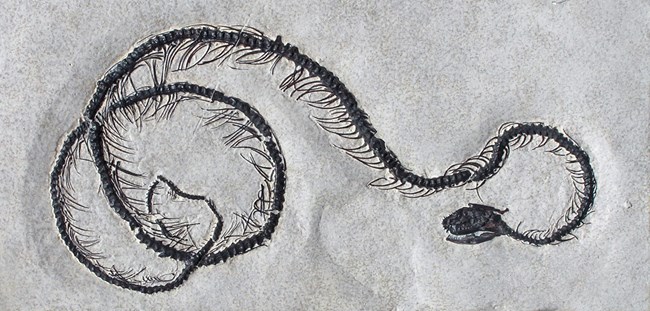
NPS photo Snakes - Boavus idelmani & Dunnophis sp.Order Squamata, Family BoidaeThe family Boidae has 44 living species found mostly in tropical and subtropical regions of Central and South America, Europa, Africa, Asia, and the western United States. Snakes in the Boidae family are carnivorous and a few are aquatic. B. idelmani is small and may belong to the neotropical subfamily Tropidophinnac (dwarf boas). Snakes are uncommon to find in the Fossil Butte Member (FBM). In 2017, a fossil appearing to be a snake of a different species was found in the FBM and has since been identified as Dunnophis sp. 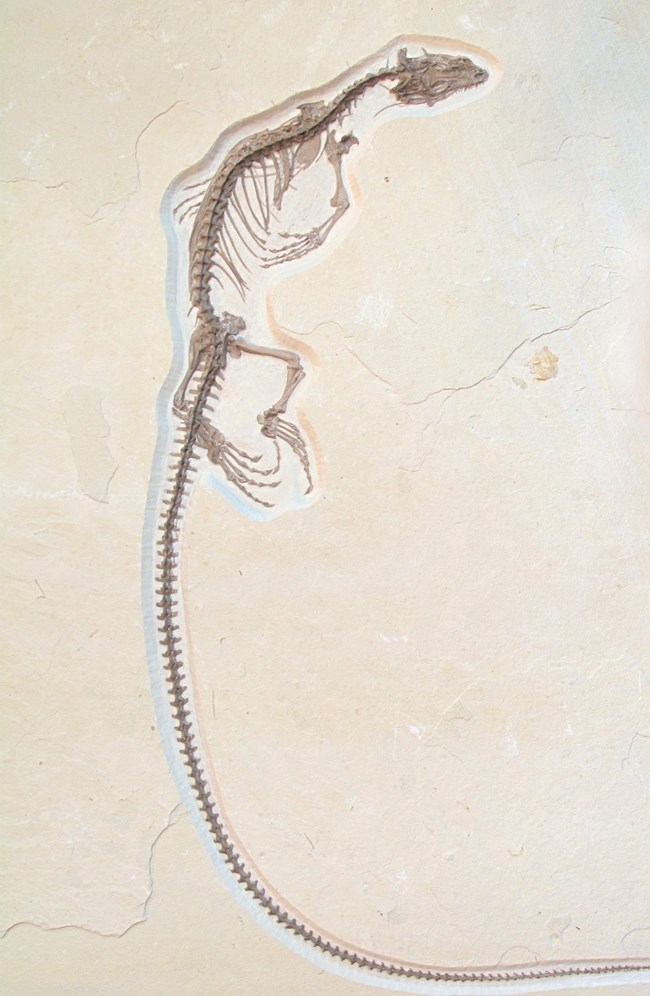
NPS Photo Lizards - 3 Species Identified: Saniwa ensidens, Bahndwivici ammoskius, & Afairiguana aviusOrder Squamata
S. ensidens is the largest lizard species from the FBM, one specimen measuring 6 feet. Like living monitor lizards, it had a long neck and powerful limbs. It most likely used its strong legs and claws to climb. Its long tail would have been used for balance and defense. The Shinisauridae family (crocodile lizards) contains one modern species, Shinisaurus crocodilurus. S. crocodilurus is found only in China and lives in freshwater systems. It spends most of its time in shallow water or overhanging branches. It is carnivorous, feeding on snails, insects, and fish. The fossil species B. ammoskius and the living S. crocodilurus are skeletally indistinguishable. The more than 300 modern members of the Iguanidae family are found throughout the Caribbean, southeastern United States, Central America, and northern South America. They are found in tropical and subtropical terrestrial habitats. They feed primarily on invertebrates like insects and spiders. 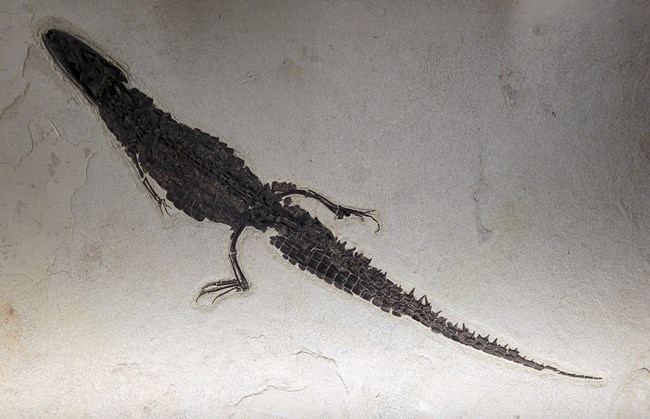
NPS Photo Crocodilians - 2 Species Identified: Borelosuchus wilsoni & Tsoabichi greenriverenisOrder Crocodilia
B. wilsoni belongs to a primitive crocodilian group and was neither true crocodile nor true alligator. It was part of a sister group to the group that contains both modern crocodiles and alligators. The largest B. wilsoni specimen discovered from the FBM was about 15 feet long. Growth rings in B. wilsoni fossil teeth indicate this species could grow as large as 16 feet long. T. greenriverenis belongs to the subfamily Caimaninae (caimans), one of the two primary lineages of the Alligatoridae family. The 6 living caiman species are native to tropical and subtropical regions of Central and South America. They inhabit slow moving, freshwater streams, lakes, ponds, and flooded wetlands. Modern caimans feed on insects, amphibians, crayfish, shrimp, and birds. Turtles - 8 Species IdentifiedAll identified turtle species had aquatic or semi-aquatic habits. The species below are organized by family.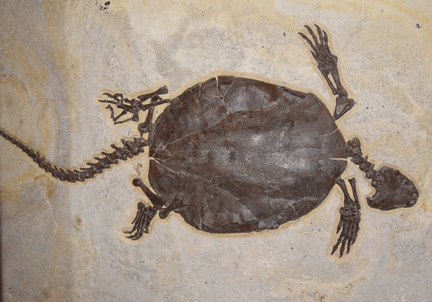
NPS Photo Baenidae Turtles - 1 Species Identified: Chisternon undatumOrder Testudines, Family BaenidaeThe extinct Baenidae family is known only from western North America. It dates back to the early Cretaceous (about 120 million years ago) and went extinct sometime in the late Eocene (about 35 million years ago). They were aquatic turtles sometimes called "bottom-walking" as they were possibly not good swimmers. They fed mostly on fish and crustaceans. They are characterized by long tails and the inability to retract heads into shells. 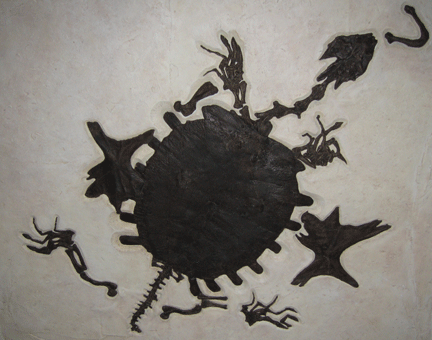
NPS Photo Soft-Shell Turtles - 3 Species Identified: Oliveremys uintaensis, Axestemys sp., & Plastomenus thomasiiOrder Testudines, Family TrionychidaeMembers of the Trionychidae family have webbed claws and feet with only 3 claws on each foot. They have solid bone on the central part of their body, covered by thick skin and lack hard bone on the outer edges of their shells. They can move quickly in open water and through muddy lake bottoms due to their light, flexible shells. Living members of the Trionychidae family are strict carnivores known to feed on fish, amphibians, invertebrates, birds, and mammals. They are found in North America, Africa, and Asia. The 25 living species of the Trionychidae family are found exclusively in freshwater systems, suggesting that the upper portion of Fossil Lake was not salty. Both O. uintaensis and Axestemys sp. would have been apex (top of the food chain) or near-apex predators of Fossil Lake. River Turtle - Baptemys wyomingensisOrder Testudines, Family DermatemydidaeThe Dermatemydidae family has only one living species, Dermatemys mawii. D. mawii is nocturnal and aquatic. It inhabits tropical, freshwater systems in Central America and southern Mexico. It feeds primarily on aquatic vegetation B. wyomingensis specimens are uncommon fossils in the FBM. Three specimens have been identified: 1 adult and 2 juveniles. Scientists find B. wyomingensis nearly identical to D. mawii. 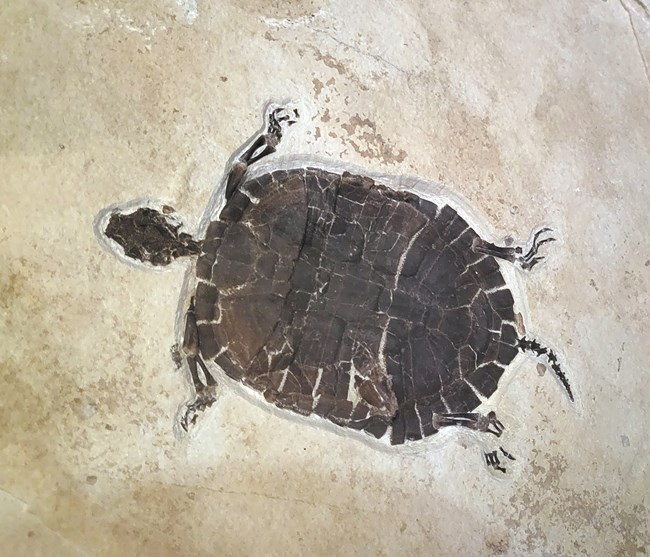
NPS Photo Pond Turtle - Echmatemys wyomingensisOrder Testudines, Family EmydidaeLiving members of the Emydidae family include over 40 modern species that are primarily aquatic, freshwater species but include some brackish (slightly salty) water tolerant and terrestrial species. The bone structure of E. wyomingensis suggests it was not a strong swimmer. It may have behaved similar to the modern painted turtle, spending much of its time out of water, basking in the sun. |
Last updated: November 20, 2025
